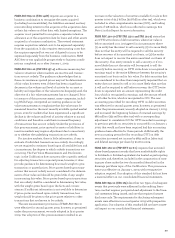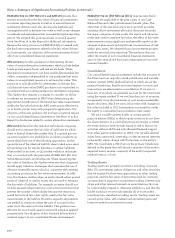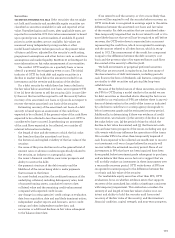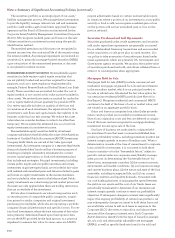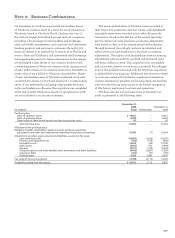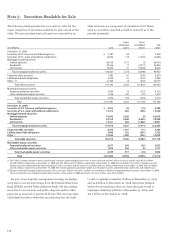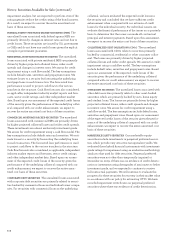Wells Fargo 2009 Annual Report Download - page 106
Download and view the complete annual report
Please find page 106 of the 2009 Wells Fargo annual report below. You can navigate through the pages in the report by either clicking on the pages listed below, or by using the keyword search tool below to find specific information within the annual report.
Note 1: Summary of Significant Accounting Policies (continued)
IMPAIRED LOANS We consider a loan to be impaired when,
based on current information and events, we determine that
we will not be able to collect all amounts due according to
the loan contract, including scheduled interest payments.
We assess and account for as impaired certain nonaccrual
commercial, commercial real estate (CRE), and foreign loan
exposures that are over $5 million and certain consumer,
commercial, CRE, and foreign loans whose terms have been
modified in a troubled debt restructuring (TDR).
When we identify a loan as impaired, we measure the
impairment based on the present value of expected future
cash flows, discounted at the loan’s effective interest rate,
except when the sole (remaining) source of repayment for the
loan is the operation or liquidation of the collateral. In these
cases we use the current fair value of the collateral, less sell-
ing costs when foreclosure is probable, instead of discounted
cash flows.
If we determine that the value of the impaired loan is less
than the recorded investment in the loan (net of previous
charge-offs, deferred loan fees or costs and unamortized pre-
mium or discount), we recognize impairment through an
allowance estimate or a charge-off to the allowance.
TROUBLED DEBT RESTRUCTURINGS In situations where, for
economic or legal reasons related to a borrower’s financial
difficulties, we grant a concession for other than an insignificant
period of time to the borrower that we would not otherwise
consider, the related loan is classified as a TDR. We strive to
identify borrowers in financial difficulty early and work with
them to modify to more affordable terms before their loan
reaches nonaccrual status. These modified terms may include
rate reductions, principal forgiveness, payment forbearance
and other actions intended to minimize the economic loss and
to avoid foreclosure or repossession of the collateral.
In cases where we grant the borrower new terms that
provide for a reduction of either interest or principal, we
measure any impairment on the restructuring as noted above
for impaired loans.
ALLOWANCE FOR CREDIT LOSSES The allowance for credit
losses, which consists of the allowance for loan losses and the
reserve for unfunded credit commitments, is management’s
estimate of credit losses inherent in the loan portfolio at the
balance sheet date.
PURCHASED CREDIT-IMPAIRED (PCI) LOANS Loans acquired in
a transfer, including business combinations where there is
evidence of credit deterioration since origination and it is
probable at the date of acquisition that we will not collect all
contractually required principal and interest payments are
accounted for using the guidance for PCI loans, which is con-
tained in the Receivables topic of the Codification. PCI loans
are initially recorded at fair value, and any related allowance
for loan losses cannot be carried over. Some loans that other-
wise meet the definition as credit impaired are specifically
excluded from the PCI loan portfolios, such as revolving loans
where the borrower still has revolving privileges.
Evidence of credit quality deterioration as of the purchase
date may include statistics such as past due and nonaccrual
status, recent borrower credit scores and recent loan-to-value
percentages. Generally, acquired loans that meet our definition
for nonaccrual status are considered to be credit-impaired.
Accounting for PCI loans at acquisition involves estimating
fair value using the principal and interest cash flows expected
to be collected on the credit impaired loans and discounting
those cash flows at a market rate of interest. The excess of
cash flows expected to be collected over the estimated fair
value is referred to as the accretable yield and is recognized
in interest income over the remaining life of the loan, or pool
of loans, in situations where there is a reasonable expectation
about the timing and amount of cash flows to be collected.
The difference between contractually required payments
and the cash flows expected to be collected at acquisition,
considering the impact of prepayments, is referred to as the
nonaccretable difference.
Subsequent to acquisition, we complete quarterly evalua-
tions of expected cash flows. Decreases in the expected cash
flows will generally result in a charge to the provision for
credit losses resulting in an increase to the allowance for loan
losses. Increases in the expected cash flows will generally
result in an increase in interest income over the remaining
life of the loan, or pool of loans. Disposals of loans, which may
include sales of loans to third parties, receipt of payments in
full or part by the borrower, and foreclosure of the collateral
result in removal of the loan from the PCI loan portfolio at its
carrying amount.
Because PCI loans are written down at acquisition to an
amount estimated to be collectible, such loans are not classi-
fied as nonaccrual even though they may be contractually
past due. We expect to fully collect the new carrying values of
such loans (that is, the new cost basis arising out of purchase
accounting). PCI loans are also excluded from the disclosure
of loans 90 days or more past due and still accruing interest.
Even though substantially all of them are 90 days or more
contractually past due, they are considered to be accruing
because the interest income on these loans relates to the
establishment of an accretable yield that is accreted into
interest income over the estimated life of the PCI loans
using the effective yield method.
Securitizations and Beneficial Interests
In certain asset securitization transactions that meet the
applicable criteria to be accounted for as a sale, assets are
sold to an entity referred to as a qualifying special purpose
entity (QSPE), which then issues beneficial interests in the
form of senior and subordinated interests collateralized by
the assets. In some cases, we may retain up to 90% of the ben-
eficial interests. Additionally, from time to time, we may also
resecuritize certain assets in a new securitization transaction.
The assets and liabilities sold to a QSPE are excluded from
our consolidated balance sheet, subject to a quarterly evalua-
tion to ensure the entity continues to meet the requirements
to be a QSPE. If our portion of the beneficial interests equals
or exceeds 90%, a QSPE would no longer qualify for off-bal-
ance sheet treatment and we may be required to consolidate







